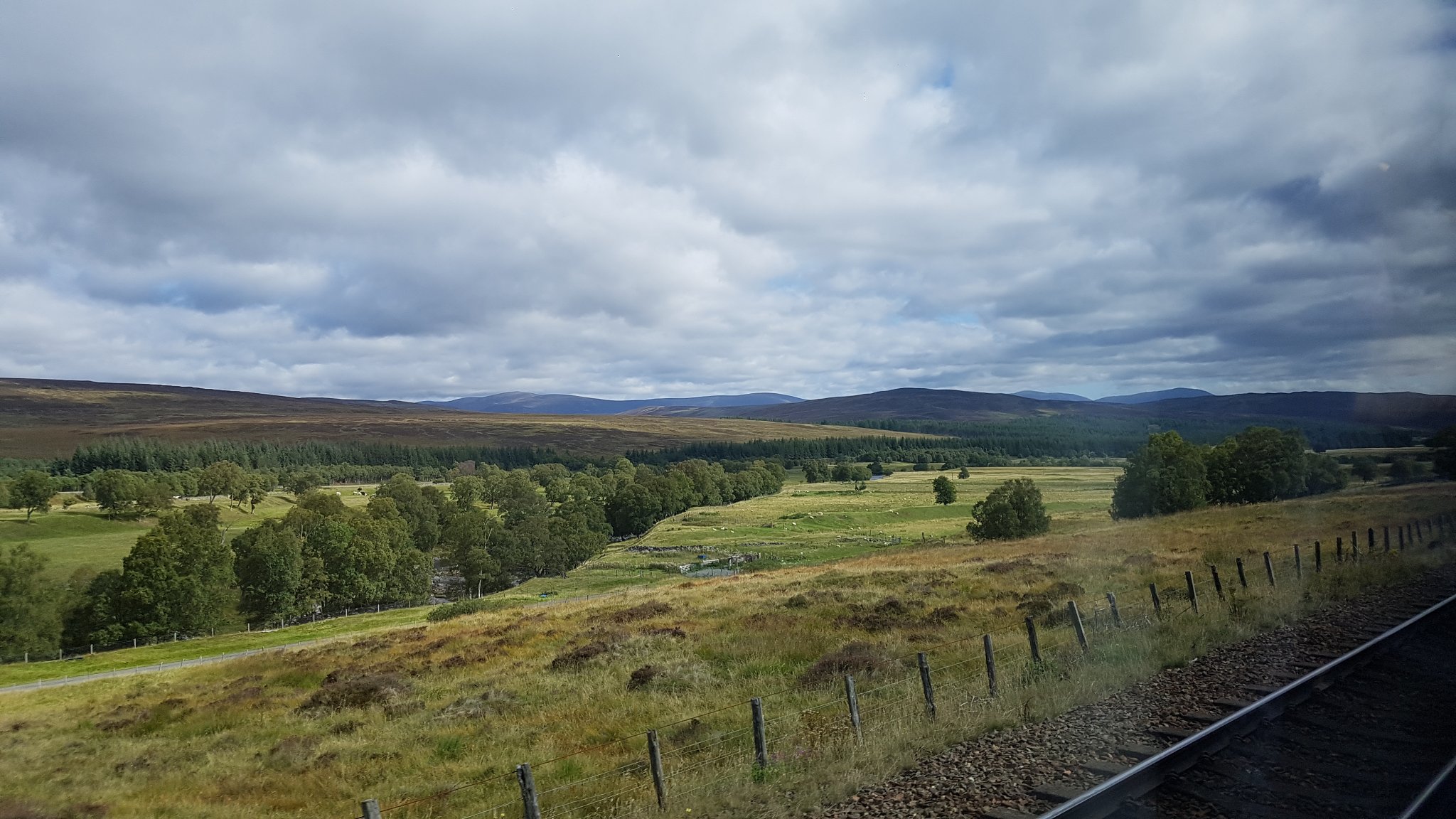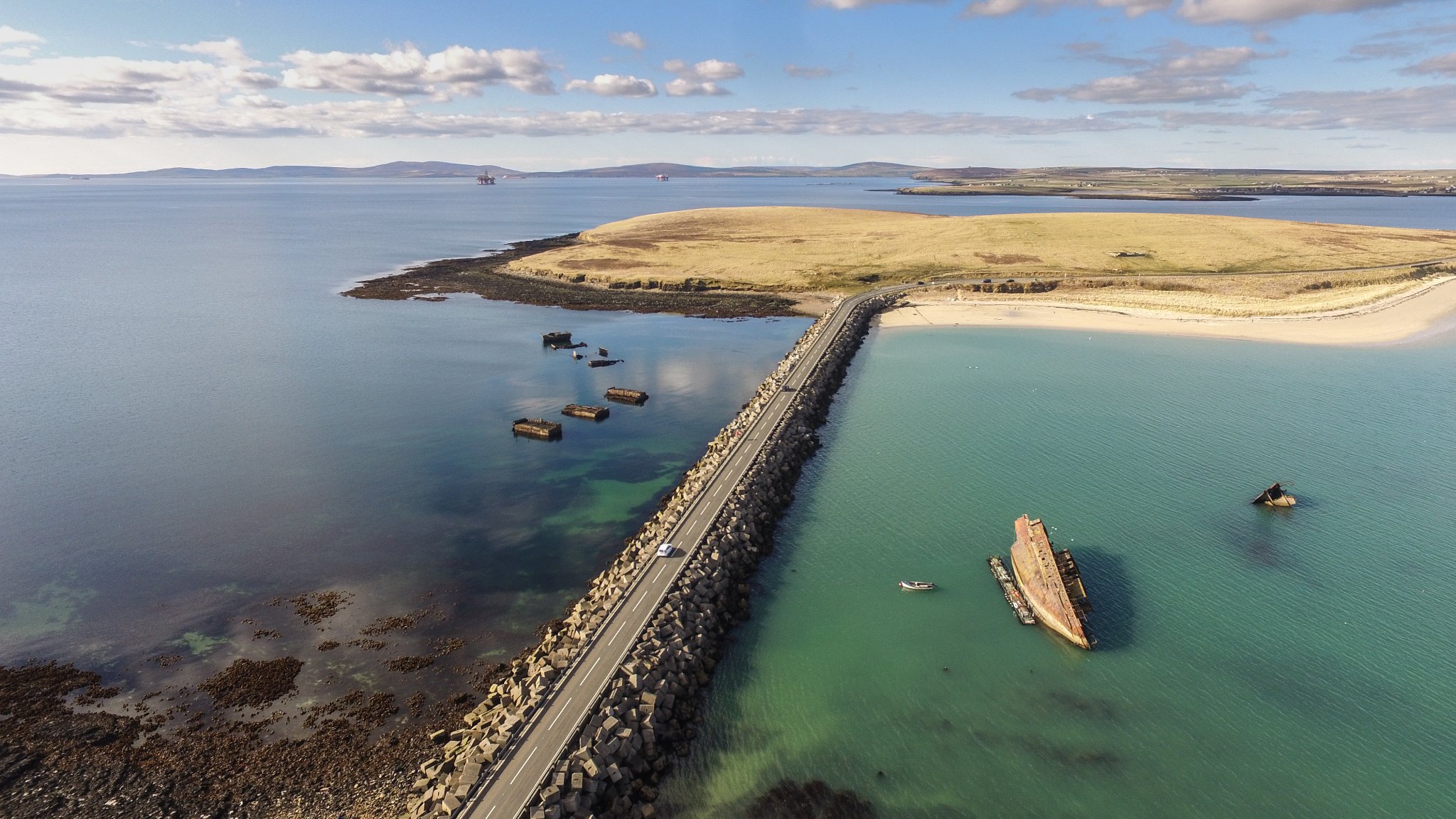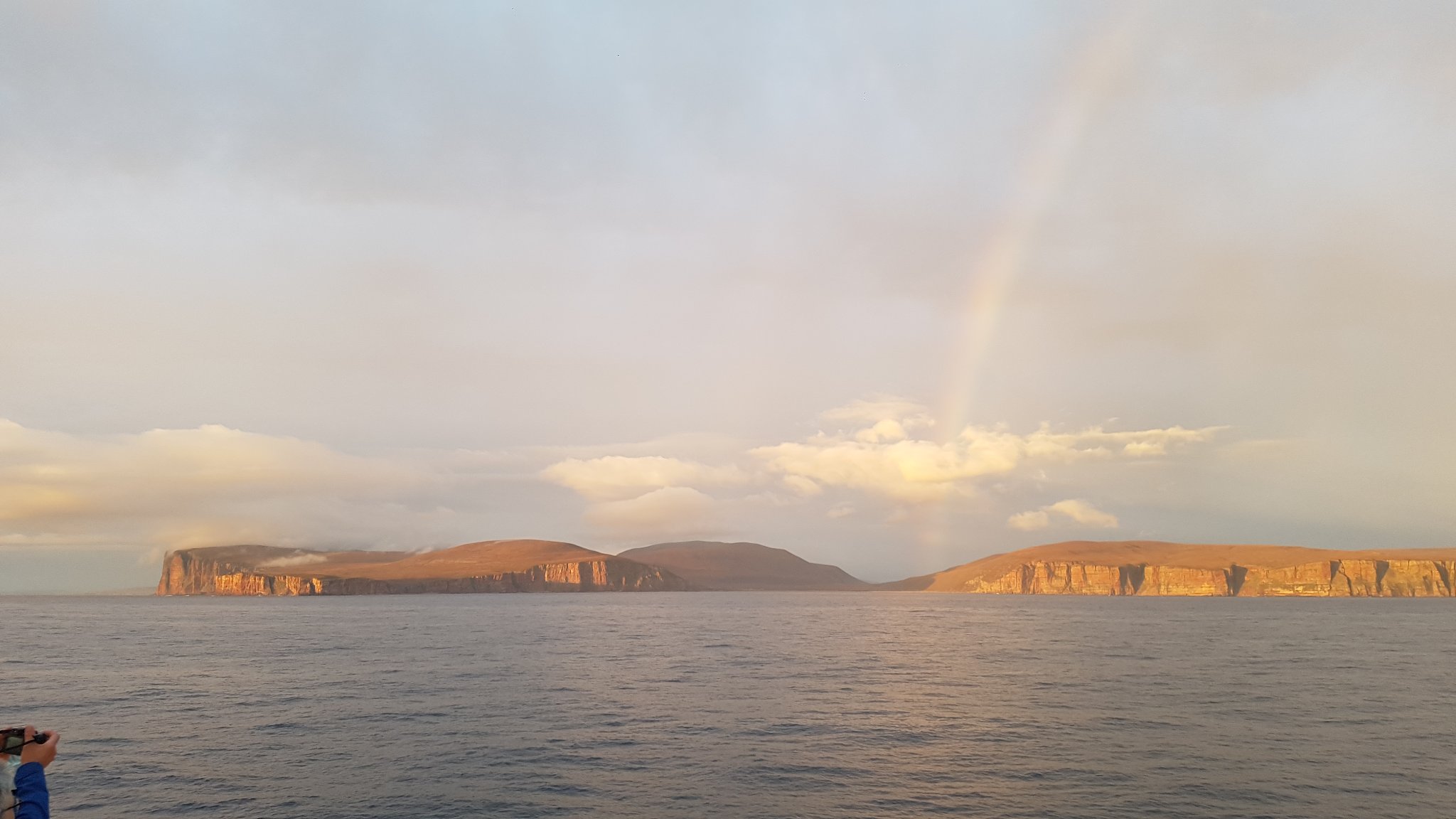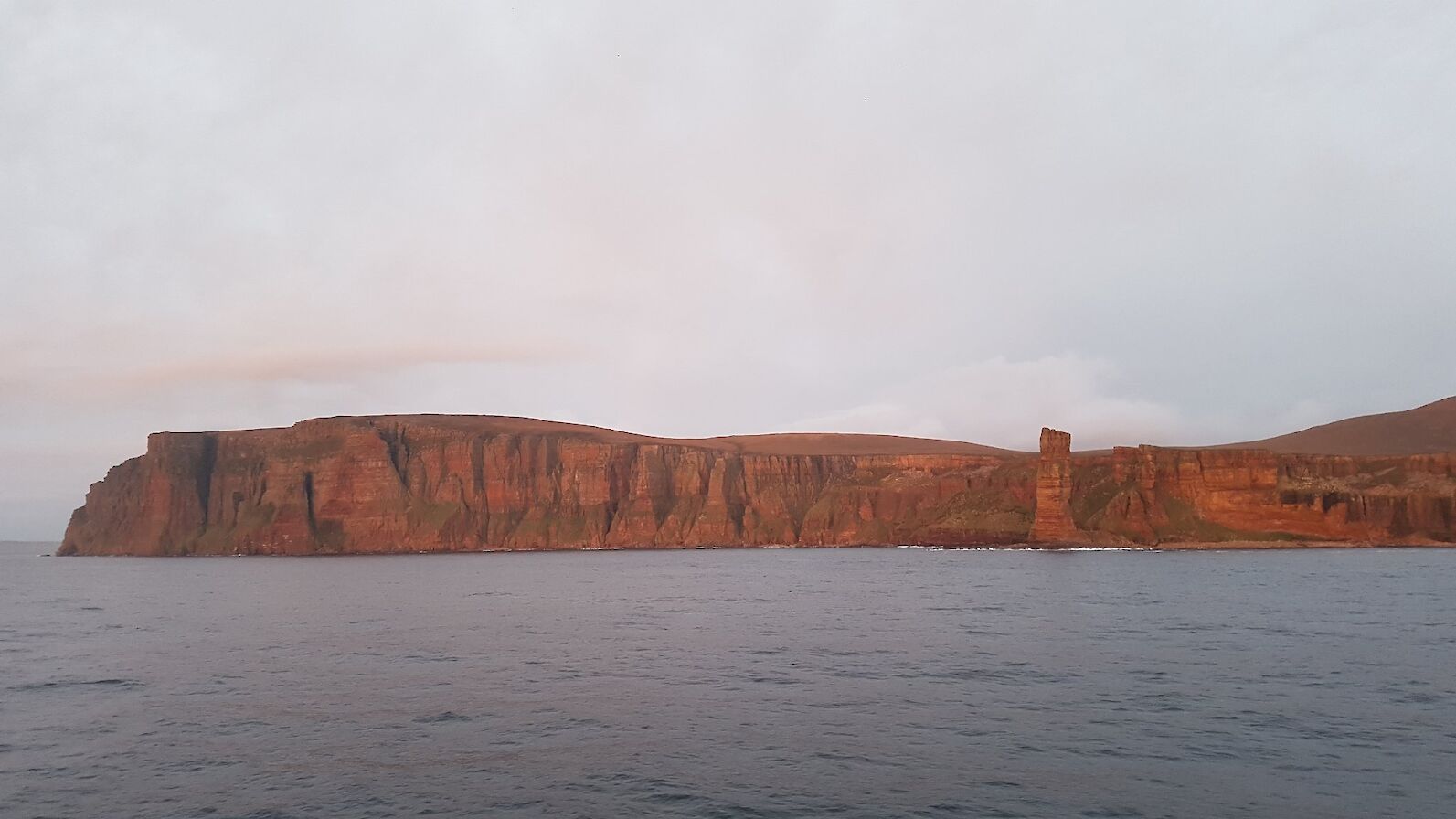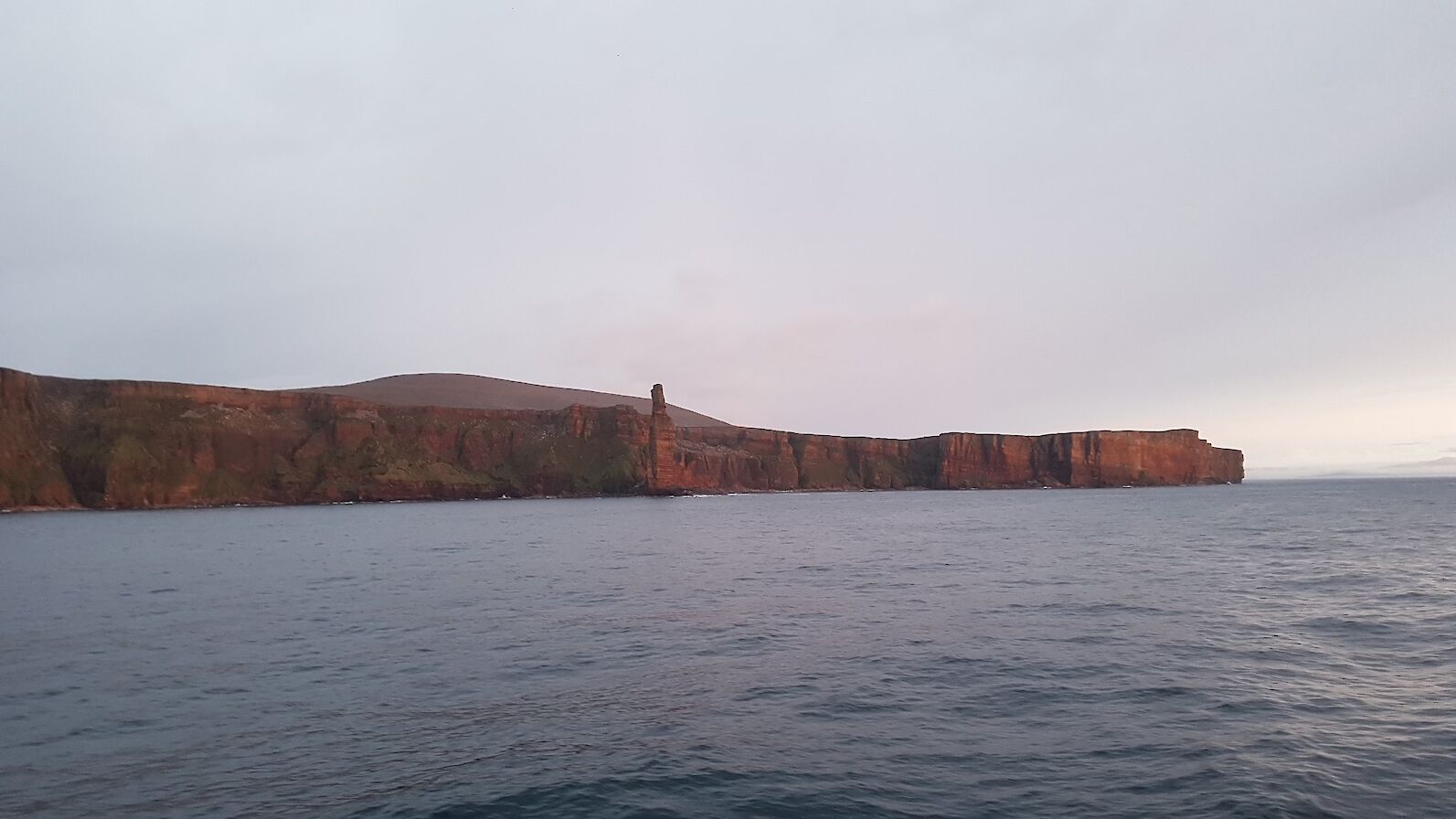Taylor St. John has recently joined her partner to start a new life in Orkney. Originally from the United States, Taylor will be keeping us up to date with her island experiences, beginning this month with her journey north.
At the lonely port of Scrabster and the very edge of mainland Britain, a large ferry waited. On her side a 7-deck-tall painted Viking pointed across the Pentland Firth towards where, according to the map, the southernmost of the Orkney Islands stood. But really all that lay in front of me was a wall of grey from sky to sea.
Eight hours earlier our train had left Glasgow, passing quickly out of the city into fields and farms beyond the Central Belt. It lumbered through the wilder Cairngorms National Park, where, framed by the train window, rapeseed fields were a shock of neon yellow in an otherwise earth-toned landscape. Heathered hills grew steeper as we moved northward and lively creeks cut rogue paths across the land.
In Inverness, capital of the Highlands, we changed trains to join the Far North Line. There was still plenty of country above us, but for me this was the frontier and beyond lay a part of Scotland whose lines hadn’t been sketched yet. I dozed, then woke disoriented a couple hours later in the middle of Forsinard Flows Reserve. The vast peatland was empty of anything apart from our train, chugging across an old, alien territory.
By now, my partner, Richy, and I had been travelling for a total of seven hours. A ScotRail worker rolled the snack cart back and forth, and back again. People got on and then they disembarked. On the earlier train, a hiker from Oregon was connecting in Inverness to the Kyle Line that leads to Scotland’s west coast. From there, he’d catch a ride to Torridon where he planned to chart a self-mapped course across the country with hundreds of other outdoors enthusiasts. We wished him luck. I drank coffee, later we cracked open a couple tins of Tennents, ate packed sandwiches and flicked our eyes between the pages of our books and the unfolding landscape out the train window. Part of me buzzed with anticipation for the unknown. But as we continued northward, another small part of suburban me grew panicky. “There’s nothing here…there’s only more nothing ahead. Turn back!”
Our train reached Thurso anyway, the end of the line. A pre-ordered taxi whisked us down the road to Scrabster where we boarded our Viking ship. About an hour in, towering sandstone cliffs appeared out of the mist and tourists stepped outside, clenching jackets tight and bracing against the wind to snap a quick photo. Beyond the mirage of Hoy and its monolith sea stacks, we made a right turn that would soon become familiar to me, into the belly of the archipelago.
Since that first overland mission—a visit which lasted only two days before following our breadcrumbs 10 hours back to Glasgow—I’ve made the trip to Orkney five times, four different ways. Richy began a Masters degree in Stromness the autumn following our April visit, and—staying put in the city—I began a year’s field study into transportation links between Scotland’s largest city and one of its farthest outposts.
On Richy’s September moving day, we battled Friday rush-hour traffic out of the city and eventually onto the A9 for a six-hour straight shot to the north coast. He didn’t stop the old Renault Modus once for fear of it failing to start again. We pulled into Gill’s Bay, east of Thurso and Scrabster, at 10 p.m. to my first-ever sighting of the northern lights, hanging like a beacon above our final destination. The next morning, a catamaran ferried us once again across the Pentland Firth, past small rock islands of ghost villages, to South Ronaldsay, connected to Orkney Mainland by a string of road across the Churchill Barriers.
In October from Edinburgh, and November from Aberdeen, I cut the journey miraculously to under an hour, washed down free Tunnock’s Caramel Wafers with milky tea and cried a little at the cost of my tickets while on board a Loganair propeller plane. On the Aberdeen flight, workers returning to the islands chatted with the tartan-dressed cabin attendant. All seemed well-acquainted. On these flights, the plane hangs just above the thick, consistent cloud that blankets Scotland, but if you’re lucky enough to have clear skies, the trip becomes worth its cost. Craggy Highland peaks and the glens and moors in-between stretch on until the land comes to an abrupt end.
Then the vivid green outlines of the islands pop into view amidst the dark blue North Sea. The little plane dips over turquoise bays and rumbles to a stop, flocked by green pasture, at Kirkwall’s airport.
One of the most important things about Orkney, I learned before I ever even arrived. Set alone, independent from the regular motions of the rest of the country, so much of what defines this place is the journey. The physical moving across or above the land, the distance covered and the time it takes, the short but essential water-crossing, they all form the context for everything that comes once you arrive.
On my final visit, I follow the original tracks. Richy and I leave Glasgow via train, connect in Inverness, continue through the Forsinard Flows to the top of Scotland at Thurso, board a Viking sea chariot as it sets off across the Pentland Firth, and, on an unusually calm and clear September evening, watch from the deck as the sun sets into a thin cloud that sits on top of the North Atlantic Ocean, its light reflecting a soft pink onto the Old Man of Hoy. A big, heavenly welcome.
We make that right turn and pull into port at Stromness in glassy waters, the stone village curling around the harbour and up a hillside. I unload two suitcases containing most of my belongings, step off the boat, and I’m home.
 Originally from the States, Taylor is a freelance writer who’s spent the last several year collecting odd jobs around the world. She’s been a lifty and fish-monger in New Zealand, a bed-maker and vineyard worker in Australia, and, most recently, a destination specialist for a tour company in Glasgow. In 2018 she joined her partner in Orkney for his job in the renewable energy industry. Taylor’s favourite thing about daily life in Orkney is savouring the moments of absolute quiet —and sea views—that are no longer reserved for holiday. Also, trying to befriend all the farm animals. You can read more of her stories on her personal blog, The Out Roads.
Originally from the States, Taylor is a freelance writer who’s spent the last several year collecting odd jobs around the world. She’s been a lifty and fish-monger in New Zealand, a bed-maker and vineyard worker in Australia, and, most recently, a destination specialist for a tour company in Glasgow. In 2018 she joined her partner in Orkney for his job in the renewable energy industry. Taylor’s favourite thing about daily life in Orkney is savouring the moments of absolute quiet —and sea views—that are no longer reserved for holiday. Also, trying to befriend all the farm animals. You can read more of her stories on her personal blog, The Out Roads.
